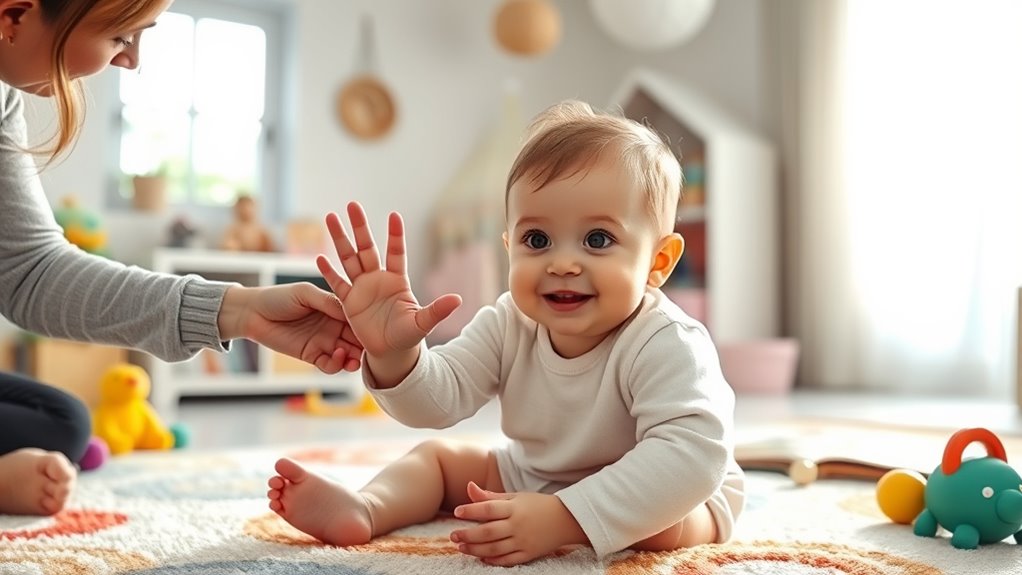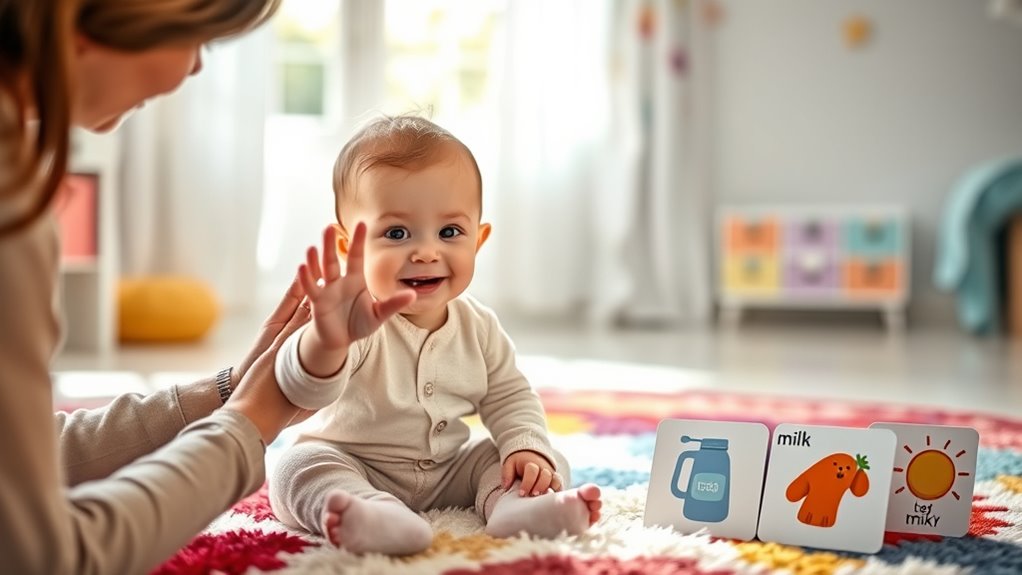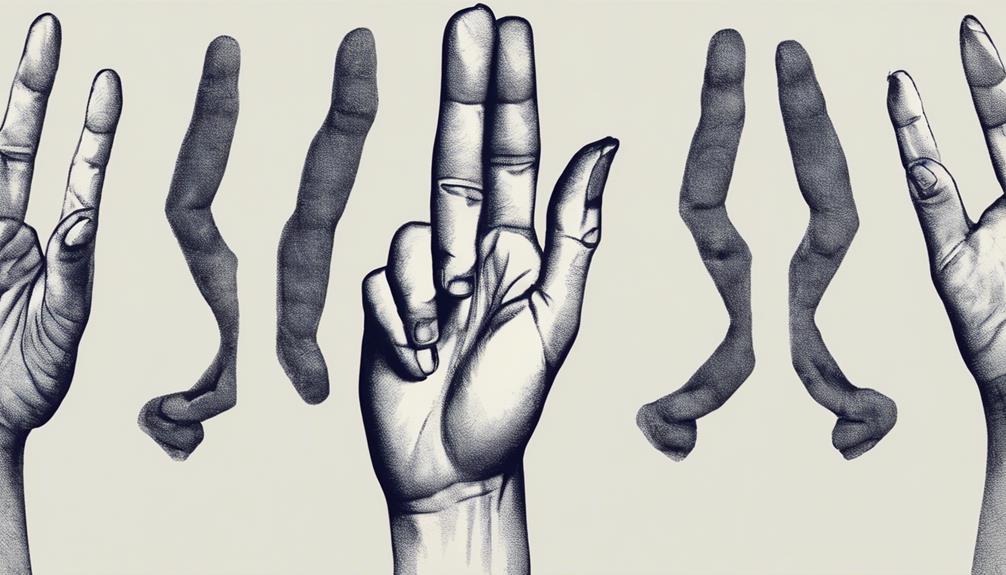Baby sign language boosts early cognitive development by engaging your baby’s visual, motor, and neural skills through intentional gestures. It helps strengthen hand-eye coordination, enhances memory, and encourages problem-solving as your little one explores and experiments with signs. This early form of communication also promotes language growth, emotional security, and stronger bonds between you and your baby. Keep exploring to discover how nurturing these skills can support your child’s bright future.
Key Takeaways
- Creates neural pathways that enhance brain development and facilitate language and motor skills.
- Stimulates neural plasticity through gesture recognition and active learning.
- Reinforces memory and recall via visual cues and routine signing.
- Encourages problem-solving and exploration during interactive sign routines.
- Supports cognitive growth by linking gestures with objects and routines, fostering understanding.
Enhancing Visual and Motor Skills Through Sign Language

Learning baby sign language can markedly boost your child’s visual and motor skills. When your little one practices gestures, they strengthen their hand-eye coordination as they focus on forming and copying signs. This process encourages precise movements, improving fine motor control, which is essential for tasks like grasping objects or feeding themselves. As they repeatedly imitate signs, your child learns to coordinate their visual input with their hand movements, sharpening their ability to process visual information. These skills develop naturally through gesture practice, making sign language an effective way to enhance their overall motor development. By engaging in regular signing, you help your child refine their motor skills in a fun, interactive way that supports their physical growth and coordination. Additionally, understanding the importance of contrast ratio and image clarity can help you choose the best visual tools to support their learning environment.
Stimulating Brain Development With Gesture-Based Communication

Engaging your baby in gesture-based communication actively stimulates their brain development by strengthening neural connections associated with language and motor skills. When your baby recognizes gestures, their brain creates new neural pathways, enhancing gesture recognition and overall cognitive growth. This process encourages the development of neural pathways that support both movement and understanding. Recognizing gestures also involves neural plasticity, which is essential for adaptable and resilient brain development.
Supporting Language Acquisition and Vocabulary Growth

Using gestures to support your baby’s language development can substantially boost their vocabulary growth. When you incorporate sign language, you enhance gesture recognition, helping your baby connect words with actions or objects. This physical engagement encourages them to understand and produce new words more quickly. As your baby begins to recognize signs, their vocabulary expands naturally because they associate gestures with meanings, making it easier to communicate before verbal skills fully develop. Consistent use of signs reinforces language patterns and supports their understanding of language structure. This active participation accelerates their ability to express needs and ideas, fostering confidence in communication. Additionally, passive voice detection tools can help ensure your writing remains clear and direct. Overall, integrating gestures into daily routines creates a rich environment for early language acquisition and vocabulary growth.
Improving Memory and Information Retention in Babies

Incorporating gestures and signs not only boosts vocabulary growth but also plays a significant role in strengthening your baby’s memory and ability to retain information. Using mnemonic devices, like associating signs with familiar objects or routines, helps your baby remember key concepts more effectively. These memory strategies make connections between actions and meanings, reinforcing learning. Repetition of signs paired with daily activities creates patterns that enhance retention. When your baby repeatedly experiences these signs, their brain forms stronger neural pathways, improving recall. Consistent signing, combined with visual cues and routines, encourages your little one to remember and recognize important information. By actively engaging their senses through gestures, you support their developing memory skills, laying a foundation for future learning and cognitive growth. Additionally, understanding how brain development influences memory can help caregivers tailor their signing practices to maximize cognitive benefits.
Fostering Early Problem-Solving Abilities

Fostering early problem-solving abilities begins with providing your baby opportunities to explore and experiment with their environment. This encourages them to develop effective problem-solving strategies and tackle cognitive challenges independently. To support this growth, create safe spaces where your baby can manipulate objects and observe outcomes. Offer simple puzzles or stacking toys to stimulate their thinking. Encourage curiosity by asking questions like, “What happens if you pull this?” or “Can you figure out how this works?” Be patient as they test solutions and learn from mistakes. Remember, each challenge helps build their confidence and cognitive skills. Incorporating vertical storage solutions and multi-functional furniture can also help organize their environment to promote independent exploration. Incorporate these approaches regularly to nurture their problem-solving abilities and help them become confident, independent thinkers.
Building Better Parent-Child Interactions and Emotional Bonds

Using baby sign language can strengthen your communication with your child, making it easier for them to share their needs and feelings. This shared understanding builds emotional security and helps your child feel more confident and safe. As you connect through signs, trust and a deeper bond naturally develop between you both. Additionally, content transparency about your interactions fosters trust and encourages your child’s willingness to communicate.
Enhances Communication Skills
When parents and babies communicate through sign language, they develop stronger connections that go beyond spoken words. This early form of communication sharpens gesture recognition, helping your baby understand and produce meaningful signs. As your child’s vocabulary grows, they can express needs and feelings more clearly, reducing frustrations. Using signs encourages active participation, making interactions more engaging and intentional. You’ll notice your baby quickly learns new signs, boosting their confidence in communication. Plus, this shared language enhances your ability to interpret your baby’s cues effectively. Incorporating fathers’ involvement in baby sign language can further strengthen the bond and support your child’s emotional growth.
Fosters Emotional Security
Developing a shared sign language with your baby not only improves communication but also deepens your emotional connection. When your baby signs their needs or feelings, it reassures caregivers that their child feels safe and understood. This mutual understanding fosters a sense of emotional security for both of you. As your baby communicates more effectively, frustration decreases because they can express themselves clearly, reducing tantrums and misunderstandings. You feel more confident responding appropriately, which builds trust and comfort. This emotional bond strengthens as you respond promptly to your baby’s signs, creating a secure environment. Additionally, introducing cultural and regional breakfast traditions can serve as a delightful way to connect over shared experiences and stories, further enhancing your bonding. Overall, baby sign language helps your child feel valued and safe, laying a foundation for healthy emotional development and a closer, more responsive relationship.
Promotes Trust and Bonding
Have you noticed how baby sign language can strengthen your connection with your child? It’s a powerful tool for trust building and deepening your emotional connection. When your baby signs their needs or feelings, you respond promptly, which shows them you’re attentive and dependable. This mutual understanding fosters emotional security and comfort. Using signs together encourages open communication, making your interactions more meaningful. It also helps your little one feel heard and valued.
Some ways baby sign language promotes trust and bonding include:
- Encourages early communication and sharing feelings
- Reinforces emotional security through consistent response
- Builds a sense of safety and predictability
- Strengthens parent-child interactions
- Enhances empathy and understanding between you and your baby
Encouraging Active Engagement and Curiosity

To foster active engagement and curiosity in your baby’s sign language journey, it’s essential to create a lively and interactive environment. Encourage sensory exploration by offering diverse objects and textures that your baby can touch, see, and feel. This stimulates their natural curiosity and helps them connect signs with real-world experiences. Use creative expression by incorporating playful gestures, expressive facial cues, and singing to make learning enjoyable. Let your baby lead the way, and respond enthusiastically to their attempts to communicate. This approach keeps their interest high and nurtures a genuine desire to explore. Incorporating appropriate learning tools can further enhance their understanding and motivation. By making sign language a fun, sensory-rich activity, you boost your baby’s motivation to learn and develop a deeper understanding of their surroundings.
Promoting Multisensory Learning Experiences

Incorporating multiple senses into your baby’s sign language learning can considerably enhance their understanding and retention. By engaging their sensory integration and encouraging tactile exploration, you help solidify new concepts. You can do this by:
- Using textured objects to demonstrate signs
- Incorporating gentle touch or massage during sign practice
- Introducing different scents associated with specific signs
- Combining visual cues with sounds or music
- Offering varied surface materials for tactile exploration
- Utilizing sound techniques to create an immersive learning atmosphere that reinforces sign language concepts.
This multisensory approach stimulates your baby’s brain, making learning more dynamic and memorable. Engaging multiple senses helps your little one connect signs with real-world experiences, reinforcing their cognitive development. When you promote sensory integration through tactile exploration, you create a rich learning environment that supports their early growth and understanding.
Laying a Foundation for Future Academic Success

Using baby sign language helps boost your child’s language skills early on, making communication smoother as they grow. It also encourages problem-solving by prompting them to think and find ways to express themselves. Building this foundation now sets the stage for future academic success and confidence.
Enhances Language Skills
Introducing baby sign language can considerably boost your child’s language skills early on, laying a solid foundation for future academic success. It encourages your little one to communicate before they develop verbal skills, reducing frustration. Many believe in sign language myths, but accurate information dispels misconceptions about delays or confusion. To support your efforts, explore reliable baby sign language resources that provide clear instructions and age-appropriate signs. Using signs regularly helps your child:
- Expand their vocabulary quickly
- Improve comprehension skills
- Develop better pronunciation
- Foster early reading readiness
- Build confidence in communication
Fosters Problem Solving
When babies learn sign language, they develop critical problem-solving skills early on by figuring out how to communicate their needs and ideas. This process encourages them to explore different problem solving strategies, such as trying various signs or gestures to get their message across. As they experiment and adjust, they build cognitive flexibility, learning to adapt their approach when one method doesn’t work. This active engagement strengthens their ability to think critically and find solutions independently. Over time, these problem-solving experiences become a foundation for future academic success, helping them approach challenges with confidence and resourcefulness. By mastering the art of communication through signs, your baby enhances essential skills that support their overall cognitive development and learning ability.
Frequently Asked Questions
At What Age Can Babies Start Learning Sign Language Effectively?
You can start introducing baby sign language around 4 to 6 months old, when your little one reaches gestural milestones in their development. Babies are most receptive during this period, aligning with their natural language acquisition timeline. At this age, they can begin to understand and imitate simple signs, making it an effective way to boost communication skills early on. Consistency helps your baby progress confidently in their signing journey.
How Does Baby Sign Language Influence Social Skills Development?
When it comes to social skills, baby sign language is a game-changer. It enhances gestural communication, allowing your baby to express their needs and feelings before they can speak. This early exchange strengthens emotional bonding, creating a foundation of trust and understanding. As your baby communicates through signs, they learn to connect with others more effectively, setting the stage for healthier social interactions and peer relationships down the line.
Are There Specific Signs That Accelerate Cognitive Growth More Than Others?
You might wonder if some signs boost cognitive growth more than others. Generally, signs with higher gesture complexity and frequent use tend to accelerate learning because they engage your baby’s attention and encourage practice. Simple, repetitive signs like “more” or “milk” are easy to master and reinforce communication, helping your little one develop cognitive skills faster. Focus on consistent, meaningful signs to maximize your baby’s language and mental development.
Can Sign Language Reduce Frustration and Tantrums in Infants?
Did you know that signing can reduce tantrums by helping infants express emotions more clearly? When you teach your baby signs for feelings like hungry or tired, they communicate emotional expression more effectively. This ease in sharing their needs strengthens parent-child bonding and decreases frustration. As a result, your little one feels understood, leading to fewer tantrums. Sign language truly fosters emotional connection and calmer interactions with your baby.
What Are the Best Methods to Teach Sign Language Consistently at Home?
To teach sign language consistently at home, focus on maintaining sign consistency and involving yourself actively. Use signs regularly during daily routines like feeding and playtime, making it a natural part of your interactions. Repeat signs often, encourage your baby to imitate, and be patient. Your involvement helps reinforce learning, making sign language a fun, seamless part of your baby’s communication development.
Conclusion
By introducing baby sign language, you give your little one a powerful tool for early growth. It boosts their cognitive, motor, and language skills while strengthening your bond. Isn’t it amazing how simple gestures can open a world of learning and curiosity? Starting now sets the stage for future success and joyful communication. So, why wait? Embrace sign language today and watch your baby thrive in ways you never imagined.











